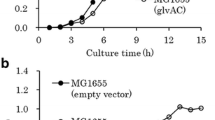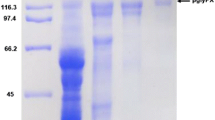Abstract
l-Menthyl α-D-glucopyranoside (α-MenG) is a glycoside derivative of l-menthol with improved water-solubility and new flavor property as a food additive. α-MenG can be synthesized through biotransformation, but its scale-up production was rarely reported. In this study, the properties of an α-glucosidase from Xanthomonas campestris pv. campestris 8004 (Agl-2) in catalyzing the glucosylation of menthol was investigated. Agl-2 can almost completely glycosylate l-menthol (> 99%) when using 1.2 M maltose as glycosyl donor. Accumulated glucose resulted from maltose hydrolysis and transglycosylation caused the inhibition of the glucosylation rate (40% reduction of the glucosylation rate in the presence of 1.2 M glucose) which can be avoided through whole-cell catalysis with recombinant E. coli. Interestingly, in spite of the poor solubility of menthol, the productivity of α-MenG reached 24.7 g/(L·h) in a 2 L catalyzing system, indicating industrialization of the reported approach.




Similar content being viewed by others
References
Choi HY, Kim BM, Morgan AMA, Kim JS, Kim WG (2017) Improvement of the pharmacological activity of menthol via enzymatic β-anomer-selective glycosylation. AMB Express 7:167
Kamatou GPP, Vermaak I, Viljoen AM, Lawrence BM (2013) Menthol: a simple monoterpene with remarkable biological properties. Phytochemistry 96:15–25
Kurosu J, Sato T, Kirimura K, Kino K, Usami S, Yoshida K, Tsugane T, Shimura S (2002) Enzymatic synthesis of α-arbutin by α-anomer-selective glucosylation of hydroquinone using lyophilized cells of Xanthomonas campestris WU-9701. J Biosci Bioeng 93:328–330
Nakagawa H, Yoshiyama M, Shimura S, Kirimura K, Usami S (1998) Anomer-selective glucosylation of l-menthol by yeast α-glucosidase. Biosci Biotechnol Biochem 62:1332–1336
Nakagawa H, Dobashi Y, Sato T, Yoshida K, Tsugane T, Shimura S, Kirimura K, Kino K, Usami S (2000) α-Anomer-selective glucosylation of menthol with high yield through a crystal accumulation reaction using lyophilized cells of Xanthomonas campestris WU-9701. J Biosci Bioeng 89:138–144
Patel T, Ishiuji Y, Yosipovitch G (2007) Menthol: a refreshing look at this ancient compound. J Am Acad Dermatol 57:873–878
Qian W, Jia Y, Ren SX, He YQ, JX F (2005) Comparative and functional genomic analyses of the pathogenicity of phytopathogen Xanthomonas campestris pv. campestris. Genome Res 15:757–767
Rogovin SP, Anderson RF, Cadmus MC (1961) Production of polysaccharide with Xanthomonas campestris. J Biochem Microbiol 3:51–63
Sato T, Hasegawa N, Saito J, Umezawa S, Honda Y, Kino K, Kirimura K (2012) Purification, characterization, and gene identification of an α-glucosyl transfer enzyme, a novel type α-glucosidase from Xanthomonas campestris WU-9701. J Mol Catal B-Enzym 80:20–27
Thorson JS, Hosted TJ, Jiang J, Biggins JB, Ahlert J (2001) Natures carbohydrate chemists the enzymatic glycosylation of bioactive bacterial metabolites. Curr Org Chem 5:139–167
Turner P, Barber C, Daniels M (1984) Behaviour of the transposons Tn5 and Tn7 in Xanthomonas campestris pv. campestris. Mol Gen Genet 195:101–107
Zhu LJ, Dong HJ, Zhang YP, Li Y (2011) Engineering the robustness of Clostridium acetobutylicum by introducing glutathione biosynthetic capability. Metab Eng 13:426–434
Acknowledgements
This study was funded by the National Nature Science Foundation of China (No. 31601445, No. 31601390 and No. 21572206).
Author information
Authors and Affiliations
Corresponding authors
Additional information
Publisher's Note
Springer Nature remains neutral with regard to jurisdictional claims in published maps and institutional affiliations.
Supplementary Information
Below is the link to the electronic supplementary material.
Rights and permissions
About this article
Cite this article
Chen, L., Zhou, Y., Lu, C. et al. Efficient production of l-menthyl α-glucopyranoside from l-menthol via whole-cell biotransformation using recombinant Escherichia coli. Biotechnol Lett 43, 1757–1764 (2021). https://doi.org/10.1007/s10529-021-03100-6
Received:
Accepted:
Published:
Issue Date:
DOI: https://doi.org/10.1007/s10529-021-03100-6




